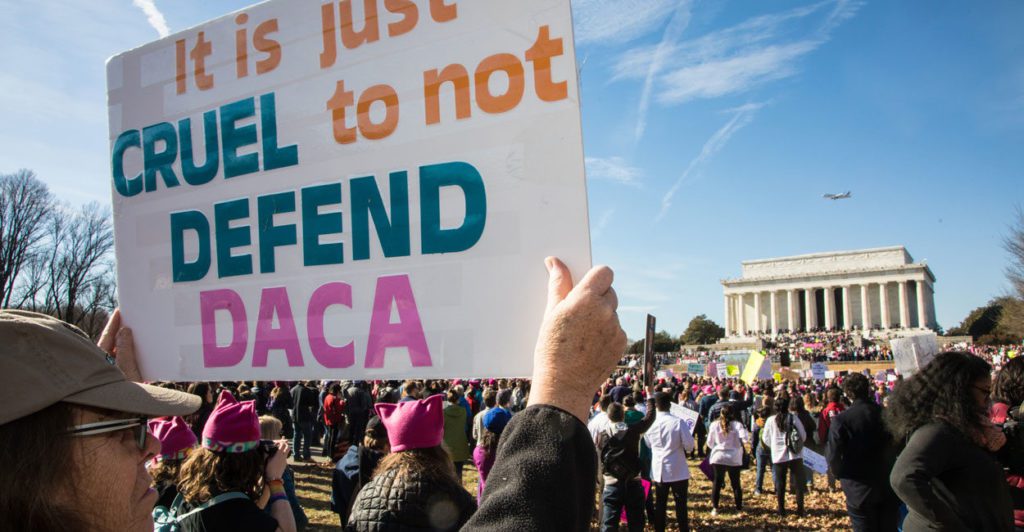To Understand Congress, Watch ‘Legally Blonde 2’
By • May 29, 2018 0 6840

Congress is out for Memorial Day week (May 28 to June 3), but unusual things will be going on around immigration proposals when the members come back — things like “Queen of the Hill” processes and “discharge petitions.” A fun way to figure out at least part of what will be going on in Congress next week is to check out “Legally Blonde 2.”
In the 2003 movie, new lawyer Elle Woods (Reese Witherspoon), a supposedly ditzy Hollywood blonde who graduated from Harvard Law School in “Legally Blonde,” joins the staff of a congresswoman (Sally Field) to pass a bill to ban animal testing. But when the congresswoman turns against her, Elle undertakes — in her sunny California way — the rare and arduous process to get a discharge petition signed by a majority of the members of Congress (218 out of 435). That move “discharges” a bill stuck in committee and submits it right to the floor for a vote.
That’s what is happening in Congress today. Ever since the Democrats shut down the government twice, briefly, over DACA (Deferred Action for Childhood Arrivals), Congress has been focused on what to do with the 18-to-30-year-olds known as DREAMers — who number somewhere between 700,000 and four million — currently residing in the country illegally.
In June of 2012, President Barack Obama ordered through an executive memo that the Department of Homeland Security grant prosecutorial discretion — that is, temporarily waive deportation — for individual illegal immigrants known as DREAMers. (The term comes from the yet-to-be-passed Development, Relief and Education for Alien Minors Act.)
Basic qualifications for the DACA program include: “came in the United States before the age of 16,” as stated in the 2012 executive order, prior to June 2007; living here consecutively for at least five years; graduating from high school or the equivalent before the age of 30; and not being convicted of a felony or a significant misdemeanor or multiple misdemeanors.
Almost one million DREAMers successfully applied for DACA status, receiving temporary job permits and deportation waivers good for the two-year, renewable, duration of the program. DACA was extended in 2014 to some 700,000 eligible beneficiaries, but was rescinded in 2017 by President Donald Trump.
DACA is currently on hold under court orders. But the permanent legalization of DACA DREAMers has become a default Democratic issue and a heated election issue. Some Republicans in vulnerable congressional districts with large populations of illegal immigrants also are concerned.
Various proposals have been submitted in the House and the Senate. All have been stalled in committees.
A discharge petition was introduced May 9 by moderate Reps. Jeff Denham (R-California), Will Hurd (R-Texas) and Carlos Curbelo (R-Florida). It would discharge the more open proposal: H.R.4976.
But once it hit the floor, Denham would then proceed to the most unusual “Queen of the Hill” process, where members could vote on any or all of four pieces of legislation, not just one. The bill that wins the most support beyond a designated threshold would move on to the Senate.
The four would be:
- The U.S.A. Act (H.R.4796), sponsored by Hurd and Pete Aguilar (D-California), would grant “conditional” permanent residency (a green card) to anyone who entered the country before the age of 18 since Dec. 31, 2013.It would add some border security elements and immigration judges, but would not extend the border wall. It would also add a Central American administrative advisor.
- The Securing America’s Future Act (H.R.4760), aka the Goodlatte Bill, would grant a three-year, renewable, legal status for only some 690,000 DACA recipients. It would institute stronger border protection and enforcement measures, as well as revise a number of legal immigration visas and priorities.
- The DREAM Act of 2017 (H.R.3440, identical to Senate bill S.1615) would give permanent status to all DACA recipients and to new applicants who hadbeen continuously physically present in the country for four years preceding this bill’s enactment who were under 18 years of age and had graduated from high school or the equivalent. Over 4 million could qualify.
- An empty slot for Speaker Paul Ryan (R-Wisconsin).
As of May 23, 213 members had signed onto the discharge petition. Only five more signatures are needed. If it passes, debate could begin after June 25.
But no one is holding their breath. Another immigration bill could be introduced in the farm bill, thus eliminating the need for a discharge petition. And Republican moderates in purple states will have to assess the possibility of a blue wave in November that could change the House majority to Democrats (or not).
But even if a bill does pass the House through the “Queen of the Hill” process, it faces almost two insurmountable obstacles: a highly unlikely vote of approval in the Republican-dominated Senate; and an almost inevitable veto by President Donald Trump.
“Why waste precious floor time — before an election — on a bill that will most likely be vetoed in the end?” asked Ryan May 14.
But Republican members of Congress could benefit. They could win their district election by voting “for” DREAMers knowing that the bill won’t pass. Senate Republicans did it in June of 2013.

